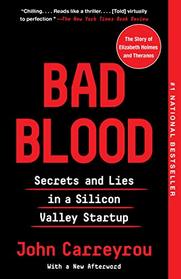I knew a little bit about the Theranos story before starting into this book but it was very little. It was a fascinating read. Watching how manipulative and threatening the company was to individuals was quite disconcerting. To see what a company can do when it has the money and has a sociopath like Elizabeth Holmes and a narcissist like Sunny Balwani running it is quite scary. It was sad to see what employees, other companies and patients went through at their diabolical hands. I do think that the booked bogged down for me in the middle. I was tired of reading the same thing happening over and over again... people being duped or fired. I was waiting for someone to wake up. When it finally did, the book started getting exciting again. Was glad to be more educated on this subject. I did not know that it was so involved. It is also upsetting to see that years after this book was published, court delays are still happening in the case against Holmes.
The Theranos' device (the blood draw would be eliminated, replaced by a pin prick drop of blood, sufficient for analysis using the miniLab) never produced consistently valid blood tests and Ms. Holmes engaged in a fraud that was not detected by large firms selling her service to the public nor by investors who did insufficient due diligence. She couldn't fool all the people all the time, but I think because she believed so strongly in herself she was able to lead a great many people down the garden path. There were people she recruited to work for the Theranos Corporation that left behind stock options in other firms, including Apple.
This was a health care provider of lab results to doctors, not a Silicon Valley tech start up that might engage in marketing hyperbole so it was terrible that the false results from the fake testing device might lead to a person getting unneeded treatment or not being given needed medical aid.
The author is a seasoned troublemaker (award winning investigative reporter) and his telling of the moves he made is as interesting in its own way as that of the decline and fall of Theranos. "What I felt was the most important point. The medical danger to which the company had exposed patients (273)." While the Wall Street Journal was investigating, the owner, Rupert Murdoch, became the largest investor in Theranos, to the tune of $125 million. He later cut his losses by selling his interest back to Theranos for a dollar to take a tax loss. Mr. Murdoch does look good in that he rebuffed Ms. Holmes' attempts to get him to influence the investigation.
Chapter One covers her background, youth, and the early fundraising for a diagnostic patch, raising $6 million by 2003. Not all investors bit and some of the employees quit or were fired when they questioned the growing discrepancies in the miniLab. Dissenters were pursued. There is room for remorse by many involved. For example CFO Henry Mosley in 2006 led the third financing round that brought in $32 million. He was among the many very qualified people that joined Theranos (and resigned).
A board resolution in December 2013 gave Holmes "one hundred votes for every share she owned, giving her 99.7 percent of the voting rights (298)."
Endnotes and index. No photos.
This was a health care provider of lab results to doctors, not a Silicon Valley tech start up that might engage in marketing hyperbole so it was terrible that the false results from the fake testing device might lead to a person getting unneeded treatment or not being given needed medical aid.
The author is a seasoned troublemaker (award winning investigative reporter) and his telling of the moves he made is as interesting in its own way as that of the decline and fall of Theranos. "What I felt was the most important point. The medical danger to which the company had exposed patients (273)." While the Wall Street Journal was investigating, the owner, Rupert Murdoch, became the largest investor in Theranos, to the tune of $125 million. He later cut his losses by selling his interest back to Theranos for a dollar to take a tax loss. Mr. Murdoch does look good in that he rebuffed Ms. Holmes' attempts to get him to influence the investigation.
Chapter One covers her background, youth, and the early fundraising for a diagnostic patch, raising $6 million by 2003. Not all investors bit and some of the employees quit or were fired when they questioned the growing discrepancies in the miniLab. Dissenters were pursued. There is room for remorse by many involved. For example CFO Henry Mosley in 2006 led the third financing round that brought in $32 million. He was among the many very qualified people that joined Theranos (and resigned).
A board resolution in December 2013 gave Holmes "one hundred votes for every share she owned, giving her 99.7 percent of the voting rights (298)."
Endnotes and index. No photos.




